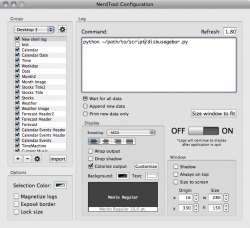Hello all,
Thanks for all your wicked scripts in this thread.
I just wanted to share my scripts. I've added some exchange rates to my desktop using Geektool 3. Might help someone out there.
These are for Indian Rupees, but you can easily change it to the currency you need.
HTML:curl --silent http://www.google.com/finance?q=USDINR | grep "span" | sed -e :a -e 's/<[^>]*>//g;//ba' | head -8 | tail -n 5 | sed '/^$/d' | sed -e '$!N;s/\n/ /' -e '$!N;s/\n/ /'; curl --silent http://www.google.com/finance?q=GBPINR | grep "span" | sed -e :a -e 's/<[^>]*>//g;//ba' | head -8 | tail -n 5 | sed '/^$/d' | sed -e '$!N;s/\n/ /' -e '$!N;s/\n/ /'; curl --silent http://www.google.com/finance?q=EURINR | grep "span" | sed -e :a -e 's/<[^>]*>//g;//ba' | head -8 | tail -n 5 | sed '/^$/d' | sed -e '$!N;s/\n/ /' -e '$!N;s/\n/ /';
@pitt1717 - replace USDINR in the code to MUTF:FAMRX, that should do the trick.
These are great scripts. I have modified them to return the exchange rate for Pounds Sterling.
One question: does anyone (@Cyrusyrus?) know how to strip out the text so that instead of getting:
1 GBP = 1.1541 EUR +0.00807
I can just get:
1.15
Many thanks.






